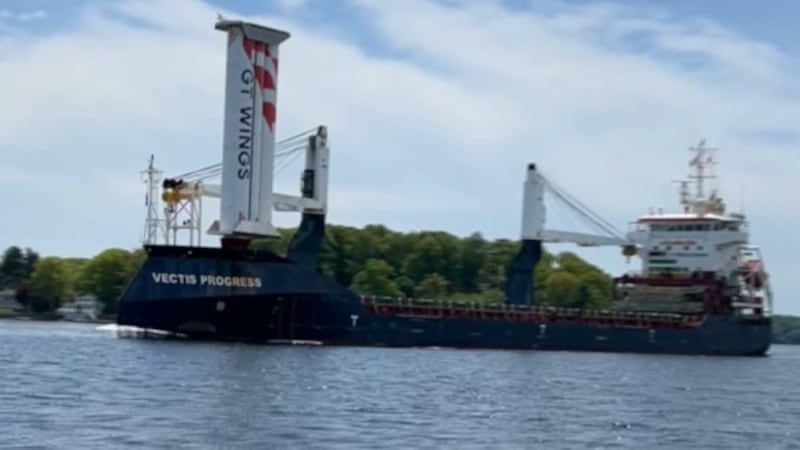## Hold onto your hats, gamers! A real-life ship on the St. Lawrence Seaway just got a serious upgrade… and it’s not just about faster travel times.

GT Wings’ Data Collection: Proving Safety and Feasibility

The Vectis Progress, a Canadian vessel navigating the St. Lawrence River, is currently adorned with a cutting-edge technology developed by UK-based company GT Wings. These airwings, designed to harness the wind’s power, are generating significant buzz within the maritime industry. According to GT Wings CEO George Thompson, the technology promises substantial fuel savings and reduced carbon emissions for ships. However, its application within the St. Lawrence Seaway faces a regulatory hurdle.
Currently, the airwing technology is not permitted for use within the Seaway. Thompson explains that GT Wings is actively collecting data during the Vectis Progress’s voyages outside the Seaway to demonstrate the technology’s safety and feasibility to Seaway officials. “These regulations move slowly, so we’re not expecting things to change very quickly,” Thompson states. He anticipates that after a year of operation, they will have compelling data to initiate discussions with the St. Lawrence Seaway authorities. “Maybe there are certain aspects or certain parts of the seaway, not the tightest areas, but I would say within a year we can have those conversations, but they will be driven by the ship owner,” he adds.

Regulations and Potential for Seaway Use
The St. Lawrence Seaway, a crucial waterway connecting the Atlantic Ocean to the Great Lakes, operates under strict regulations to ensure the safe and efficient movement of vessels. Introducing new technologies, such as airwings, requires thorough evaluation and approval processes to address potential safety concerns and ensure compatibility with existing infrastructure and traffic patterns. The regulatory framework for the Seaway is overseen by the St. Lawrence Seaway Management Corporation, which sets and enforces rules and regulations for navigation.
GT Wings’ data collection efforts aim to demonstrate that airwing technology meets the Seaway’s safety standards. The company’s focus on gathering comprehensive data on the system’s performance, stability, and potential impact on surrounding vessels is crucial for gaining regulatory approval. Thompson emphasizes that the process will be driven by ship owners who see the benefits of airwing technology and are willing to advocate for its adoption within the Seaway.

The Role of Ship Owners in Driving Innovation
Ship owners play a pivotal role in driving innovation within the maritime industry. Their willingness to invest in new technologies and their demand for improved efficiency, reduced emissions, and cost savings often influence the development and adoption of groundbreaking solutions. In the case of GT Wings’ airwing technology, the support of ship owners like the one operating the Vectis Progress is essential for its wider acceptance and implementation.
By embracing new technologies like airwings, ship owners can demonstrate their commitment to environmental sustainability and operational efficiency. They can also gain a competitive advantage by lowering their operating costs and reducing their carbon footprint. This proactive approach to innovation can position ship owners as leaders in the industry and contribute to a more sustainable future for shipping.

Beyond the St. Lawrence: A Global Perspective
Other Applications of Airwing Technology
While the Vectis Progress’s deployment marks a significant step for GT Wings, the potential applications of airwing technology extend far beyond the St. Lawrence Seaway. The technology’s ability to harness wind power for propulsion offers significant advantages for various types of vessels, including:
- Cargo ships: Airwings can reduce fuel consumption and emissions for large cargo vessels, leading to significant cost savings and environmental benefits.
- Tankers: Similar to cargo ships, tankers transporting oil and other liquids can benefit from increased efficiency and reduced emissions using airwing technology.
- Passenger ferries: Airwings can enhance the sustainability of passenger ferry operations, offering a cleaner and more environmentally friendly mode of transportation.
- Fuel savings: Airwings can significantly reduce fuel consumption, leading to substantial cost savings for ship owners.
- Reduced emissions: By relying on wind power, airwings can dramatically reduce greenhouse gas emissions, contributing to a cleaner environment.
- Increased efficiency: Airwings can enhance the overall efficiency of vessels, allowing them to travel faster and farther with less fuel.
The Potential for Widespread Adoption in Shipping
The maritime industry is continuously seeking ways to improve efficiency, reduce emissions, and lower operating costs. Airwing technology presents a compelling solution to these challenges. As more data becomes available and the technology matures, it is likely to gain wider adoption across the industry.
Potential benefits driving widespread adoption include:
The Impact on the Maritime Industry’s Carbon Footprint
The maritime industry is a significant contributor to global carbon emissions. Airwing technology offers a promising pathway to reduce the industry’s environmental impact. By enabling ships to utilize wind power, airwings can displace fossil fuels, leading to substantial reductions in greenhouse gas emissions.
As the shipping industry moves towards decarbonization, airwing technology is expected to play a crucial role in achieving sustainability goals. Widespread adoption of this technology has the potential to significantly mitigate the maritime industry’s carbon footprint and contribute to a cleaner and more sustainable future.
Conclusion
So, there you have it – the St. Lawrence Seaway, a vital artery of global trade, is embracing the future. This latest vessel, equipped with cutting-edge technology, isn’t just a technological marvel; it’s a harbinger of a seafaring revolution. From enhanced navigation and efficiency to improved safety and environmental responsibility, the implications are vast. This isn’t just about one ship; it’s about a ripple effect that will likely transform the entire shipping industry. Imagine a future where vessels navigate autonomously, powered by renewable energy, minimizing their environmental footprint while optimizing routes and optimizing cargo delivery. This could revolutionize global trade, making it faster, more efficient, and sustainable. The future of the St. Lawrence Seaway, and perhaps all waterways, is looking brighter, smarter, and more connected than ever before. The question now is, are we ready to sail into this new era?
